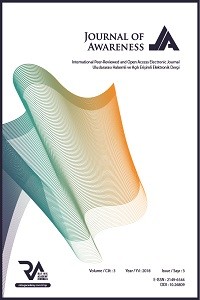Abstract
References
- ANDERSON, T.W., C. HSIAO (1982). “Formulation and estimation of dynamic models using panel data”, Journal of Econometrics, 18, 47-82.
- ARELLANO, M., S. BOND (1991). “Some Tests of Specification for Panel Data: Monte Carlo Evidence and an Application to Employment Equations”, The Review of Economic Studies, 58 (2), 277-297.
- BALL, L. (2000). “Policy Rules and External Shocks”, NBER Working Papers, 7910.
- CLARIDA, R. ve M. GERTLER (1997). "How the Bundesbank Conducts Monetary Policy?", Reducing Inflation, Motivation and Strategy, The University of Chicago Press, 363-413.
- FAIGLE, U., KERN, W., STILL, G., ‘Algorithmic Principles of Mathematical Programming’, Springer Science, 2002, Dordrecht
- HANSEN, L. (1982). “Large sample properties of generalized method of moments estimation”, Econometrica, 50 (3), 1029-1054.
- HOLTZ-EAKIN, D., W. NEWEY, H.S. ROSEN (1988). “Estimating Vector Autoregressions with Panel data”, Econometrica, 56 (6), 1371-1395.
- LEEPER, E. M. (1991). “Equilibria under ‘active’ and ‘passive’ monetary and fiscal policies”, Journal of Monetary Economics 27 (November 1991), 129-47.
- LEEPER, E. M. (1993). “The policy tango: Toward a holistic view of monetary and fiscal effects”, Federal Reserve Bank of Atlanta Economic Review, 18 (4), 1-27.
- MISHKIN, F.S. (2000). "From Monetary Targeting to Inflation Targeting: Lessons from the Industrialized Countries", NBER Working Papers.
- PEREZ, J.J., P. HIEBERT (2002). “Identifying Endogenous Fiscal Policy Rules for Macroeconomic Models”, European Central Bank Working Paper No. 156.
- SARGAN, J.D. (1980). “Some Tests of Dynamic Specification for a Single Equation”, Econometrica, 48, 879-897.
- SVENSSON, L.E.O. (1997). “Optimal Inflation Target, Conservative Central Banks and Linear Inflation Contracts”, American Economic Review, 87 (1), 97-114.
- ZELLNER, A., H. Theil (1962). “Three stage least squares: Simultaneous estimate of simultaneous equations”, Econometrica, 29, 54-78.
Abstract
Financial and monetary policies are aiming to increase production growth and keeping inflation and unemployment at a minimum. However, the complex interactions between economic variables and the range of economic instruments complicate to obtain these goals. In addition, the economical and behavioural habits of the society and the market economy structure of the nation force the state to choose among the policies. In this context, it is necessary to understand the characteristics of behavioural economics beside the theoretical issues. As, 5-Yearly Development Plans were used for national economic planning, which is used for the purpose of establishing economic policy, the model based Macro-Turkey program was used during a short period. Today, the General Directorate of Economic Modeling and Strategic Studies "Medium Term Program Key Macroeconomic and Financial Targets" reports make proposals for economic policy making and development. The aim of the work is to estimate and compare the fiscal and monetary policy model of Turkey. The research question considers also the recession periods after 2008-2009 international crises. Some governments had forcefully recourse fiscal policies to overcome the recession. There was a wide consensus that the financial markets had played a decisive role in the current economic problems. A quarterly 2006-2017 data was collected with 44 observations, which includes consumer price inflation 2003 constant prices, policy interest rate, broad money, central government spending, gross fixed capital formation, GDP with constant prices, tax revenues, gross external dept. Dynamic equation system estimates will be held simultaneously with the appropriate variables and indicators. The goal of maximum growth will be optimized under the constraints of Turkish current economic condition. Therefore, the econometric analysis and optimization techniques will be used consecutively. The macro economical Keynesian coefficients are expected to occur with the model. These coefficients are the main ones used to simulate the dynamic stochastic general equilibrium (DSGE) models used by the central governments to calibrate their policies. The response of the output to fiscal and financial shocks might quantifiable through simulating the model
References
- ANDERSON, T.W., C. HSIAO (1982). “Formulation and estimation of dynamic models using panel data”, Journal of Econometrics, 18, 47-82.
- ARELLANO, M., S. BOND (1991). “Some Tests of Specification for Panel Data: Monte Carlo Evidence and an Application to Employment Equations”, The Review of Economic Studies, 58 (2), 277-297.
- BALL, L. (2000). “Policy Rules and External Shocks”, NBER Working Papers, 7910.
- CLARIDA, R. ve M. GERTLER (1997). "How the Bundesbank Conducts Monetary Policy?", Reducing Inflation, Motivation and Strategy, The University of Chicago Press, 363-413.
- FAIGLE, U., KERN, W., STILL, G., ‘Algorithmic Principles of Mathematical Programming’, Springer Science, 2002, Dordrecht
- HANSEN, L. (1982). “Large sample properties of generalized method of moments estimation”, Econometrica, 50 (3), 1029-1054.
- HOLTZ-EAKIN, D., W. NEWEY, H.S. ROSEN (1988). “Estimating Vector Autoregressions with Panel data”, Econometrica, 56 (6), 1371-1395.
- LEEPER, E. M. (1991). “Equilibria under ‘active’ and ‘passive’ monetary and fiscal policies”, Journal of Monetary Economics 27 (November 1991), 129-47.
- LEEPER, E. M. (1993). “The policy tango: Toward a holistic view of monetary and fiscal effects”, Federal Reserve Bank of Atlanta Economic Review, 18 (4), 1-27.
- MISHKIN, F.S. (2000). "From Monetary Targeting to Inflation Targeting: Lessons from the Industrialized Countries", NBER Working Papers.
- PEREZ, J.J., P. HIEBERT (2002). “Identifying Endogenous Fiscal Policy Rules for Macroeconomic Models”, European Central Bank Working Paper No. 156.
- SARGAN, J.D. (1980). “Some Tests of Dynamic Specification for a Single Equation”, Econometrica, 48, 879-897.
- SVENSSON, L.E.O. (1997). “Optimal Inflation Target, Conservative Central Banks and Linear Inflation Contracts”, American Economic Review, 87 (1), 97-114.
- ZELLNER, A., H. Theil (1962). “Three stage least squares: Simultaneous estimate of simultaneous equations”, Econometrica, 29, 54-78.
Details
| Primary Language | English |
|---|---|
| Subjects | Archaeology |
| Journal Section | Research Article |
| Authors | |
| Publication Date | August 9, 2018 |
| Published in Issue | Year 2018 Volume: 3 Issue: 3 |


